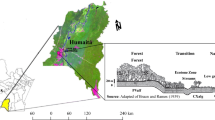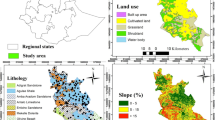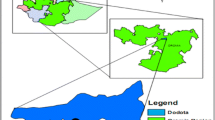Abstract
Purpose
The influence of tropical fruticulture that was established in Amazonian dark earth was investigated by considering changes in soil physical and chemical properties. Soil samples were collected at two layers (0–0.1 and 0.1–0.2 m) under two dissimilar conditions: naturalized archaeological site (Amazonian dark earth) vs. tropical fruticulture.
Material and methods
We evaluated soil texture (clay, sand, and silt contents), bulk density, soil porosity, soil resistance, carbon stock (C stock), soil moisture, geometric mean diameter, weighted average diameter, average diameter < 2 mm, average diameter > 2 mm, soil pH, exchangeable cations (Al3+, Ca2+, Mg2+, K+), potential acidity, soil organic carbon (SOC), and available P.
Results and discussion
Our results emphasized the soil physico-chemical changes as influenced by tropical fruticulture in the Amazonian dark earth. The PCA and SEM showed that the tropical fruticulture had an overall negative effect on available P, Ca2+, GMD, soil aggregation, SOC, C stock, bulk density, and soil resistance.
Conclusion
The results of our study highlighted the importance of considering the Amazonian dark earth as an archaeological site, and when necessary for food production, we must consider soil management practices to promote soil ecosystem avoiding soil quality loss. Thus, long-term experiments in the studied sites considering soil management may exploit different feedback among tropical fruticulture and the Amazonian dark earth.



Similar content being viewed by others
Data availability
Data will be made available on a reasonable request.
Code availability
Not applicable.
References
Asare MO (2022) Anthropogenic dark earth: evolution, distribution, physical, and chemical properties. Eur J Soil Sci 73:e13308. https://doi.org/10.1111/ejss.13308
Batistão AC, Holthusen D, Reichert JM, Santos LAC, Campos MCC (2020) Resilience and microstructural resistance of archaeological dark earths with different soil organic carbon contents in western Amazonia. Brazil Geoderma 363:e114130. https://doi.org/10.1016/j.geoderma.2019.114130
Beniaich A, Guimarães DV, Avanzi JC, Silva BM, Acuña-Guzman SF, Santos WP, Silva MLN (2023) Spontaneous vegetation as an alternative to cover crops in olive orchards reduces water erosion and improves soil physical properties under tropical conditions. Agric Water Manag 279:e108186. https://doi.org/10.1016/j.agwat.2023.108186
Bhattacharyya R, Bhatia A, Ghosh BN, Santra P, Mandal D, Kumar G et al (2023) Soil degradation and mitigation in agricultural lands in the Indian Anthropocene. Eur J Soil Sci 74:e13388. https://doi.org/10.1111/ejss.13388
Black CA (1962) Methods of soil analysis, Part 2. In Agronomy monograph; Black, CA, Ed. Am Soc Agron: Madison, WI USA 9:771–1572
Blanco H, Lal R (2023) Restoration and management of degraded soils. In: Soil conservation and management. Springer, Cham. https://doi.org/10.1007/978-3-031-30341-8_14
Celentano D, Rousseau GX, Paixão LS, Lourenço F, Cardozo EG, Rodrigues TO, Silva HR, Medina J, de Sousa TMC, Rocha AE, Rei FO (2020) Carbon sequestration and nutrient cycling in agroforestry systems on degraded soils of eastern Amazon, Brazil. Agrofor Syst 94:1781–1792. https://doi.org/10.1007/s10457-020-00496-4
de Souza TAF, Silva LJR, Laurindo LK, Nascimento GS, Campos MCC (2023a) Impact of ecological stages on the soil microbiota and soil abiotic factors in tropical and subtropical Brazilian regions. Arch Microbiol 205:e335. https://doi.org/10.1007/s00203-023-03677-8
Dhaliwal SS, Sharma V, Shukla AK, Kaur J, Gupta RK, Verma V, Kaur M, Singh VK, Singh P (2023) Interactive effect of land use systems on depth-wise soil properties and micronutrients minerals in North-Western. India Heliyon 9:e13591. https://doi.org/10.1016/j.heliyon.2023.e13591
Enck BF, Campos MCC, Pereira MG, Souza FG, Santos OAQ, Diniz YVFG, Martins TS, Cunha JM, Lima AFL, Souza TAF (2022) Forest-fruticulture conversion alters soil traits and soil organic matter compartments. Plants 11:e2917. https://doi.org/10.3390/plants11212917
Forstall-Sosa KS, Souza TAF, Lucena EO, da Silva SAI, Ferreira JTA, Silva TN, Santos D, Niemeyer JC (2020) Soil macroarthropod community and soil biological quality index in a green manure farming system of the Brazilian semi-arid. Biol 76:907–917. https://doi.org/10.2478/s11756-020-00602-y
Geremew B, Tadesse T, Bedadi B, Gollany HT, Tesfaye K, Aschalew A (2023) Impact of land use/cover change and slope gradient on soil organic carbon stock in Anjeni watershed. Northwest Ethiopia Environ Monit Assess 195:e971. https://doi.org/10.1007/s10661-023-11537-7
Gomes DMC, Costa AF, Munita CS, Cunha JPL (2023) Archaeological evidence of the development of a regional society in Santarém (AD 1000–1600). Lower Amazon: a Path to Understanding Social Complexity J World Prehist. https://doi.org/10.1007/s10963-023-09177-3
Gondim EFG, Souza T, Portela JC, Santos D, Nascimento GS, Silva LJR (2023) Soil physical-chemical traits and soil quality index in a tropical Cambisols as influenced by land uses and soil depth at Apode Plateau, Northeastern Brazil. Int J Plant Prod. https://doi.org/10.1007/qs42106-023-00256-1
Grossman RB, Reinsch TG (2002) The solid phase. In: Dane JH, Topp GC (eds) Methods of soil analysis. Soil Science Society of America, Physical methods, pp 201–414
Hill J, Black S, Arujo-Murakami A, Boot R, Brienen R, Feldpausch T, Leigue J, Murakami S, Monteagudo A, Pardo G, Peña-Claros M, Phillips OL, Toledo M, Vos V, Zuidema P, Mayle FE (2023) An assessment of soil phytolith analysis as a palaeoecological tool for identifying pre-Columbian land use in Amazonian rainforests. Quaternary 6:e33. https://doi.org/10.3390/quat6020033
Hou M, Zhao X, Wang Y, Lv X, Chen Y, Jiao X, Sui Y (2023) Pedogenesis of typical zonal soil drives belowground bacterial communities of arable land in the Northeast China Plain. Sci Rep 13:e14555. https://doi.org/10.1038/s41598-023-41401-0
ITA (1979) Selected methods for soil and plant analysis; IITA Manual Services: Ibadan, Nigeria
Kumar J, Kalita H, Rekhung W, Alone RA, Angami T, Jini D, Makdoh B, Touthang L, Khatri N, Singh AP, Sinha NK, Kumar D, Chaudhary, (2023) Dynamics of soil organic carbon of jhum agriculture land-use system in the heterogeneous hill of Arunachal Pradesh. India Sci Rep 13:e12156. https://doi.org/10.1038/s41598-023-38421-1
Mataveli G, Chaves M, Guerrero J, Escobar-Silva EV, Conceição K, Oliveira G (2022) Mining is a growing threat within indigenous lands of the Brazilian Amazon. Remote Sens 14:4092–5004. https://doi.org/10.3390/rs14164092
Nascimento GS, Souza TAF, Silva LJR, Santos D (2021) Soil physico-chemical properties, biomass production, and root density in a green manure farming system from tropical ecosystem, North-eastern Brazil. J Soils Sed 21:2203–2211. https://doi.org/10.1007/s11368-021-02924-z
Ortiz DC, Souza TAF, Pech TM, Bartz MLC, Baretta D, Siminski A, Niemeyer JC (2021) Soil ecosystem changes by vegetation on old-field sites over five decades in the Brazilian Atlantic Forest. J for Res. https://doi.org/10.1007/s11676-021-01368-y
R Core Team (2018) R: a language and environment for statistical computing. R Foundation for Statistical Computing, Vienna, Austria. https://www.R-project.org/. Accessed Jul 2023
Rodríguez L, Soárez JC, Rodriguez W, Artunduaga KJ, Lavelle P (2021) Agroforestry systems impact soil macroaggregation and enhance carbon storage in Colombian deforested Amazonia. Geoderma 384:e114810. https://doi.org/10.1016/j.geoderma.2020.114810
Rostain S, McKey D (2023) Historical ecology in Amazonia. In: Colonese AC, Milheira RG (eds) Historical ecology and landscape archaeology in Lowland South America. Interdisciplinary Contributions to Archaeology. Springer, Cham. https://doi.org/10.1007/978-3-031-32284-6_4
Santos LAC, Pedron FA, Souza Junior VS, Silva LS, Campos MCC, Araujo JKS (2023) Magnetic and spectral signature of anthropogenic and non-anthropogenic soils to identify pedogenetic processes in Amazonia. Brazil Geoderma Reg 32:e00622. https://doi.org/10.1016/j.geodrs.2023.e00622
Schmidt MJ, Py-Daniel AR, Moraes CP, Valle RBM, Caromano CF, Teixeira WG, Barbosa CA, Fonseca JÁ, Magalhães MP, Santos DSC, Silva RS, Guapindaia VL, Moraes B, Lima HPL, Neves EG, Heckenberger MJ (2014) Dark earths and the human built landscape in Amazonia: a widespread pattern of anthrosol formation. J Archaeol Sci 42:152–165
Silva SR, Santos HP, Lollato RP, Santi A, Fontaneli RS (2021) Long-term effects of tillage systems on liming efficiency, soil chemical properties and wheat yield in Southern Brazil. Soil Res 60:497–510. https://doi.org/10.1071/SR21023
Soares MDR, Souza ZM, Campos MCC, Silva RB, Esteban DAA, Noronha RL, Gomes MGS, Cunha JM (2021) Land-use change and its impact on physical and mechanical properties of Archaeological Black Earth in the Amazon rainforest. CATENA 202:e105266. https://doi.org/10.1016/j.catena.2021.105266
Solleiro-Rebolledo E, García-Ramírez P, Sedov S, Cabadas-Báez H, Rivera-Uria Y, Ibarra-Arzave G, Pi-Puig T (2023) Interaction of geomorphic processes and long-term human impact in the soil evolution: a study case in the tropical area at Veracruz. Mexico Catena 227:e107072. https://doi.org/10.1016/j.catena.2023.107072
Souza T, Barros IC, Silva LJR, Laurindo LK, Nascimento GS, Lucena EO, Martins M, Santos, (2022) Soil microbiota community assembling in native plant species from Brazil’s legal Amazon. Symb. https://doi.org/10.1007/s13199-021-00828-7
Souza PR, de Lima HV, da Silva GB, Moura AS (2023b) Limiting water content for compaction induced by mechanized operations in the soil with oil palm in the Eastern Amazon. J Soil Sci Plant Nutr. https://doi.org/10.1007/s42729-023-01474-2
Souza TAF, Silva LJR, Nascimento GS (2023c) Amazonian deforestation and its influence on soil biotic factors and abiotic properties. Pedobiol. https://doi.org/10.1016/j.pedobi.2023.150865
Teixeira PC, Donagema GK, Ademir F, Teixeira WG (2017) Manual de Métodos de Análise de Solo, 3rd ed; Embrapa: Brasília, Brazil
Tsolis V, Barouchas P (2023) Biochar as soil amendment: the effect of biochar on soil properties using VIS-NIR diffuse reflectance spectroscopy, biochar aging and soil microbiology—a review. Land 12:e1580. https://doi.org/10.3390/land12081580
Veldkamp E (1994) Organic carbon turnover in three tropical soils under pasture after deforestation. Soil Sci Soc Am J 58:175–180
Wang YJ, He XH, Meng LL, Zou Y-N, Wu Q-S (2023) Extraradical mycorrhizal hyphae promote soil carbon sequestration through difficultly extractable glomalin-related soil protein in response to soil water stress. Microb Ecol 86:1023–1034. https://doi.org/10.1007/s00248-022-02153-y
WRB - IUSS Working Group (2015) World Reference Base for soil. World Soil Resources Reports, Rome, Italy, FAO
Xiao T, Li P, Fei W, Wang J (2023) Effects of vegetation roots on the structure and hydraulic properties of soils: a perspective review. Sci Total Environm 906:e167524. https://doi.org/10.1016/j.scitotenv.2023.167524
Zeng Y, Hao D, Park T, Zhu P, Huete A, Myneni R, Knyazikhin Y, Qi J, Nemani RR, Li F, Huang J, Gao Y, Li B, Ji F, Köhler P, Frankenberg C, Berry JÁ, Chen M (2023) Structural complexity biases vegetation greenness measures. Nat Ecol Evol. https://doi.org/10.1038/s41559-023-02187-6
Zhang Q, Bol R, Amelung W, Missong A, Siemens J, Mulder I, Willbold S, Müller C, Muniz AW, Klumpp E (2021) Water dispersible colloids and related nutrient availability in Amazonian Terra Preta soils. Geoderma 397:e115103. https://doi.org/10.1016/j.geoderma.2021.115103
Acknowledgements
We thank the GEBIOS (Soil Biology Research Group, @Gebios) for practical support. We thank FAPESQ-PB for facilitating the post-doc studies of the second author.
Funding
Tancredo Souza was supported by a research fellowship from Paraíba State Research Fundation (FAPESQ-PB), Brazil.
Author information
Authors and Affiliations
Contributions
Conceptualization, WBN, TAFS, JJCS, BCM, and MCCC; methodology, IAO, TAFS, and MCCC, WOA; software, MCCC, TAFS, and WBN; validation, WBN and TAFS; formal analysis, TAFS and MCCC; investigation, WBN, TAFS, JJCS, BCM, and MCCC; resources, IAO, WOC, TAFS, and FPO; data curation, MCCC; writing—original draft preparation, TAFS and MCCC; writing—review and editing, TAFS and MCCC; visualization, WBN, TAFS, JJCS, BCM, IAO, WOA, FPO, and MCCC; supervision, TAFS; project administration, MCCC; funding acquisition, MCCC and FPO. All authors have read and agreed to the published version of the manuscript.
Corresponding author
Ethics declarations
Ethics approval
Not applicable.
Consent for publication
We confirm that this manuscript has not been published elsewhere and it is not under consideration by another journal. All authors approved the manuscript and they agreed with the submission to Journal of Soils and Sediments. We have read and have abided by the statement of ethical standards for manuscripts submitted to Journal of Soils and Sediments.
Content to participate
Not applicable.
Competing interest
The authors declare no competing interests.
Additional information
Publisher's Note
Springer Nature remains neutral with regard to jurisdictional claims in published maps and institutional affiliations.
Supplementary Information
Below is the link to the electronic supplementary material.
Rights and permissions
Springer Nature or its licensor (e.g. a society or other partner) holds exclusive rights to this article under a publishing agreement with the author(s) or other rightsholder(s); author self-archiving of the accepted manuscript version of this article is solely governed by the terms of such publishing agreement and applicable law.
About this article
Cite this article
do Nascimento, W.B., de Souza, T.A.F., Silva, J.J.C. et al. Physical–chemical characterization of Amazonian dark earth as influenced by tropical fruticulture in western Brazil’s Legal Amazon. J Soils Sediments (2024). https://doi.org/10.1007/s11368-024-03757-2
Received:
Accepted:
Published:
DOI: https://doi.org/10.1007/s11368-024-03757-2




